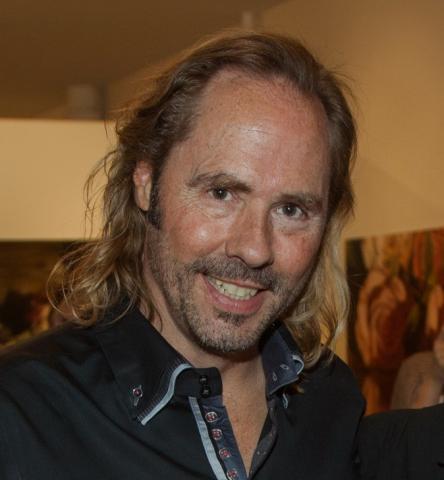VISUAL COMMUNICATIONS, 1979 - 1983
NELSON: When did you graduate from ACAD? What was your major?
Paul VAN GINKEL: My first year was 1979. It was called ACA back then and was a department of SAIT. It was not yet a degree-granting program, only a diploma. After my first year I applied to Visual Communications (VC), however, I was not accepted because my GPA was not high enough to make the cut. So I continued with another year of general studies and was then successful as a direct entry into VC the following year. Ultimately I was planning on a 5 year program. In September of my last (5th) year, I applied for and was offered a job as an editorial illustrator at the Calgary Herald newspaper. I left ACA to take the job, so I didn’t actually graduate.
NELSON: And did you continue to work in the area of visual communications, or did you change your interests?
VAN GINKEL: My ultimate career goal was to be a fine art painter. However, I thought the best art education would be in VC. I anticipated the larger variety of subjects, discipline and I knew that a business focus in VC would make me more skilled and employable. After leaving ACA in my last year to work at the Calgary Herald, I also did freelance illustration and fine art painting until I resigned and started my career as a full time painter effective January 1st, 1990. Its now been over 29 years.
NELSON: It’s interesting to me that you envisioned Visual Communications as good preparation for being a fine art painter. I agree with you. But I don’t think that’s everyone’s inclination…
VAN GINKEL: Back then and over the years I’ve come to realize that a lot of the international painters that I admire and are successful often had initially pursued commercial art (VC) as an education. They were initially book and movie poster illustrators and advertising artists. In advertising art and illustration its usually a team effort with the focus being a specific objective and goal. Having artistic freedom isn’t always an effective way to begin an art career. I feel collaboration and learning builds a better foundation.
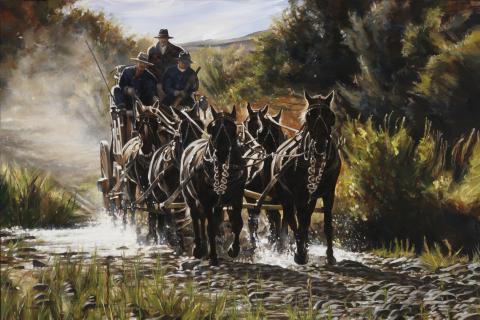
Crossing the Line (2011), 40 X 60", oil
NELSON: A lot of graduates use ACAD as a creative stepping stone. How did your education at ACAD direct your career?
VAN GINKEL: I’m a big believer in formal education, I feel the student always has an advantage over the person who doesn’t have [formal education]. Despite always being open minded, going to ACAD was never intended to direct me in a direction other than art. With art you never stop learning — there’s always more to explore, if you’re so creatively inclined. Some young artists make the mistake of feeling they already have their artistic voice and vision so they often resist educational direction and advise from formal instruction. I feel that’s a big mistake; you have to be like a sponge your entire life, and especially at the beginning of your art career.
I feel ACAD was a good and important fit for me. I’m mindful that everything in my past has brought me to where I am now and. In this moment, I’m content, inspired, happy, ambitious and optimistic. I have a balanced life and proud of what I have accomplished. ACAD is a big part of my past, my 4-plus years there were instrumental in shaping my career.
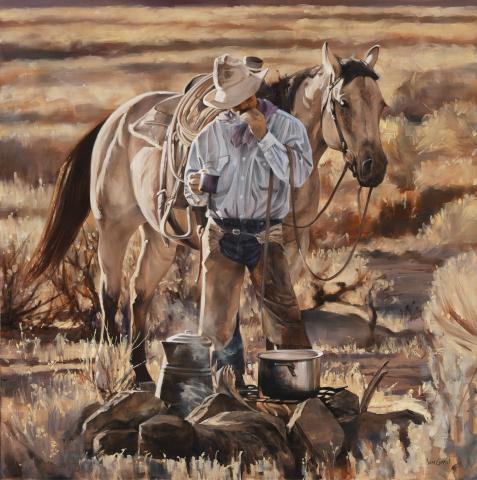
Light Up (2015), 50 X 50", oil
NELSON: Were there specific instructors that influenced you?
VAN GINKEL: After my first year when I was not accepted into my major (VC), I considered dropping out. I spoke with several instructors and mentors, but it was Richard Halliday in particular that was quite insistent I remain in ACA. I don’t know if that was his standard answer for my situation or if he saw some potential in me, but he in particular comes to mind. Another important instructor was Jerry Kalback. He was an excellent Visual Communications instructor. He and I have been in touch over the years.
NELSON: Given your experiences, what advice would you give a student when it comes to establishing a creative business?
VAN GINKEL: Well, I could talk for hours on the business of art, however, the number one thing by far is to have the right perspective and attitude, not just in in art but in all of life. Specifically, be optimistic, positive, disciplined, hardworking and “never surrender.” Make no excuses, don’t point fingers and be completely accountable.
In my particular case, I’ve worked full time in the arts for close to 36 years, 30 of those years have been as a fine art painter. I’m now 59 and feel I’m only in mid-career. Historically, most artists attain their greatest growth and success in their 60s and 70s. The artist must also establish a business acumen if they want to not only survive but thrive. You don’t have to be a genius at it, however, at the very least employ some basic common business sense. For example, ask yourself: how would I like to be treated when I go into a store and express interest in buying something? Naturally, you want to be acknowledged and provided with all the information you require. The artist needs to operate in the same manner including being professional and following up with every lead and expression of interest.

Die For Love (2012), 40 X 60", oil
Everyone has opportunities, but how many actually recognize them and ultimately do something about it? Being self-employed in the arts is operating in the great unknown. One could choose to be terrified of the unknown or choose to be energized, inspired and optimistic. Nothing could happen or everything can happen. For example, I may not have a sale for a month, or I might sell 6 paintings tomorrow. Despite always working towards success, I never really know for certain. Always look for opportunities and take calculated steps to increase your odds of success. One thing that is certain is that everything is always changing so the artist must adapt, and be relentless, persistent and consistent.
NELSON: What insights did your four years at ACAD give you when looking at things?
VAN GINKEL: One of the biggest things is acquiring a thick skin and being open minded. All art is subjective so it’s important to understand that. Take the good with the bad and stay even-keeled. Learning how to represent and market yourself as a professional is an acquired skill. It takes time and focus. In many respects, exhibiting your work is also market research — you are receiving feedback from an audience. The ultimate validation of a piece is usually the sale, however, at times I’m surprised by what sells first versus what I thought was the strongest work. I pay that knowledge forward.
One of the many things I do during an exhibition is pay attention to which pieces attract the most attention and then I try to determine why. This is very important for the creating, marketing and selling of art. Naturally, with every painting I create I need to be proud of, however, I also can’t be foolish business-wise if a particular series doesn’t have market appeal. If one series is successful, then I’m going to obviously focus in that direction and have it run its course. It’s simply common sense and good business. My main career objective is to sell the work on a consistent basis so I can continue painting for the rest of my life. To me, success in the arts is doing it full time for the rest of my life, not being “rich and famous.”
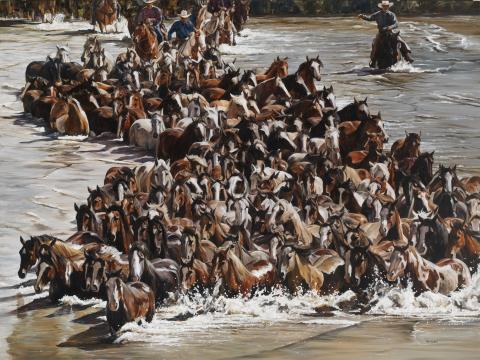
Equine Tsunami (2013), 60 X 80", oil
NELSON: After graduation, what obstacles did you encounter and how did you overcome them?
VAN GINKEL: The perspective I choose is feeling as if I never really have problems or obstacles, only challenges to overcome. I had cancer, and was on chemo for a year, however, I didn’t look at it as a problem, only a setback to conquer and learn from. I dealt with it and here I am today. It’s part of my life cycle and journey. If I didn’t sell paintings in certain shows, I wasn’t discouraged as it was a learning opportunity and something I had to evolve and adjust to — everything happens for a reason. It’s just part of the whole process. My attitude is the same whether I sell out an exhibition or don’t sell a thing — and both have happened!
There’s always opportunities, they’re out there for everyone. I’m very assertive and relentless in my business pursuits, however, I certainly don’t expect to succeed on everything I pursue. As long as I get my piece of the pie I am satisfied. One never “fails” if they are not successful in some of their initiatives. True failure is not even trying.
NELSON: How could you imagine ACAD supporting our alumni?
VAN GINKEL: Since leaving ACAD in 1983 I’ve never been contacted by ACAD, I suspect because I was a “drop out." I certainly don’t hold that against ACAD as I’m very grateful for the education I received. However, I now feel I can provide far more for ACAD than they can for me. Perhaps through this interview I can offer some insight and inspiration for future artists to focus more on the business side of art. It’s never a compromise to promote, commercialize and market ones work. It's virtually impossible to work successfully in the industry without doing so. I don’t formally mentor or teach, however, I’m always open and available to offer help and wisdom where necessary, especially if the person is committed. Regarding how ACAD can support alumni… perhaps something as simple as being invited to exhibit in an alumni exhibit would be a good start.
NELSON: Why do you think creativity matters in the big picture?
VAN GINKEL: Creativity educates directly and indirectly in a variety of ways. By engaging with the arts, whether it be looking at a painting or watching theatre, one can learn about one’s self and have a fulfilling experience. Several people can stand in front of a given painting and say what the painting is, but what it means to each of them can be entirely different. We can all have difference experiences with art, and subsequently, different interpretations. Appreciating art can not only enhance people’s lives, but also allows them to discover insights about themselves. If art is a catalyst for that, then clearly it has profound importance.
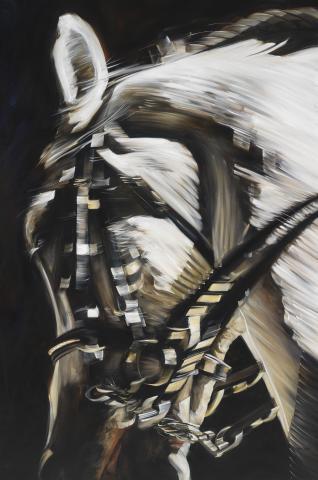
Unbounded (2011), 72 X 48", oil
NELSON: What do you think the role is of ACAD and the Alumni in shaping our cultural and economic prosperity? Let’s start on the local level.
VAN GINKEL: The role of ACAD is to provide culture to our society through educating their students. I feel culture is the blood of society and it has to be respected, appreciated and embraced. It’s the artists’ role to infiltrate the city with creative expression and influence. It can be buying tickets to theatre, a musical and dance events, or buying visual art and paying decent money for it. For ACAD and its alumni, it’s both a privilege and a responsibility to operate as artists within our larger society. In addition to creating and supporting the arts, we also have to be mindful of the influence of art. The artist must not be reckless and irresponsible with their creative expressions because art is potentially a powerful and influential vehicle on society and thinking.
NELSON: Who are your favourite painters or artists? People you have drawn inspiration from either now or long ago.
VAN GINKEL: Despite staying relatively up to date on contemporary artists, I look to the masters for my true inspiration: Velasquez, Frans Hals, Caravaggio, Sargent, etc.
